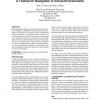IWEC
2010
14 years 1 months ago
2010
Mobile games are based on the physical movement of players in a game world, combining real world with virtual dimensions. As the real world defies control, the magic circle, the bo...
ASSETS
2008
ACM
14 years 1 months ago
2008
ACM
Understanding how pointing performance varies in real world computer use and over time can provide valuable insight about how systems should accommodate changes in pointing behavi...
AMAST
2008
Springer
14 years 1 months ago
2008
Springer
d Abstract) David Kitchin, Evan Powell, and Jayadev Misra The University of Texas at Austin The real world is inherently concurrent and temporal. For simulating physical phenomena ...
WSC
2008
14 years 2 months ago
2008
Research in parallel simulation has been around for more than two decades. However, the number of papers reporting on its application to real world problems is limited. At the 200...
AAAI
2007
14 years 2 months ago
2007
Recently, social text streams (e.g., blogs, web forums, and emails) have become ubiquitous with the evolution of the web. In some sense, social text streams are sensors of the rea...
APGV
2010
ACM
14 years 3 months ago
2010
ACM
People underestimate egocentric distances in head-mounted display virtual environments, as compared to estimates done in the real world. Our work investigates whether distances ar...
UIST
1995
ACM
14 years 3 months ago
1995
ACM
Current user interface techniques such as WIMP or the desktop metaphor do not support real world tasks, because the focus of these user interfaces is only on human–computer inte...
ESORICS
2006
Springer
14 years 3 months ago
2006
Springer
Abstract. Trust-management systems address the authorization problem in distributed systems. They offer several advantages over other approaches, such as support for delegation and...
DEXAW
2004
IEEE
14 years 3 months ago
2004
IEEE
Data exchange between embedded systems and other small or large computing devices increases. Since data in different data sources may refer to the same real world objects, data ca...
UIST
1993
ACM
14 years 3 months ago
1993
ACM
Maintaining knowledge of current position and orientation is frequently a problem for people in virtual environments. In this paper we present a toolset of techniques based on pri...




